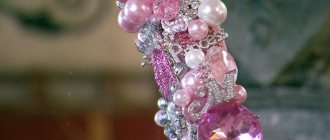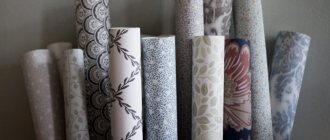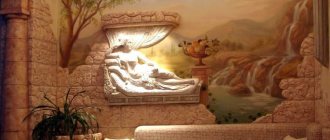Main types of fishing
Artistic painting is usually called patterns applied with paint for the purpose of decoration. And this can be called one of the oldest types of folk art. The first objects found with elements of painting date back to the 18th century. It is known for certain that people knew how to paint with patterns much earlier, as this is mentioned in ancient chronicles.
Toys, kitchen utensils, chests, sleighs, and the hut itself - all this is only a small part of the items that were decorated by folk craftsmen. In the old days, people were limited in traveling long distances; the technique of applying patterns, the composition of paints and other secrets that the master passed on to his students remained in one separate region.
And the ancient Russian painting, characteristic of this area, was recognizable by its unique style of drawing. It is this feature that gave the names to all currently known trends in Russian folk art.
For a long time, people had no other material at hand other than wood, so painting on wood became one of the most extensive in Rus'. Today, art historians identify the following schools of ancient painting:
- Mezenskaya;
- Khokhloma;
- Gzhel;
- Zhostovo;
- Fedoskino;
- Gorodets;
- palekh;
- Severodvinskaya;
- Prikamskaya
Today, all these types and schools of Russian folk painting exist, since there are masters who managed to preserve the ancient manner and technique. Their product is popular and is often purchased as a gift or as a souvenir. How much do we know about history just by buying a beautiful thing?
Gorodets wood painting
In the villages located near the district town of Gorodets, Nizhny Novgorod province, they made spinning wheel bottoms - one of the elements of a hand-made spinning wheel. They sat on it while working, and because it was not needed, they hung the bottom on the wall, so the craftsmen tried to decorate it in every possible way. Did you know that according to an ancient custom, when getting married, the groom had to break his bride’s bottom in order to then make her a new one.
Gorodets painting is characterized by a three-tiered artistic composition, where the first and lower tier are occupied by plot motifs, and the middle is divided by a stripe in the form of a repeating floral pattern. Horses, riders, young ladies, dogs, birds, trees, hunters - these are the main characters of Gorodets painting. In addition to spinning wheels, Donetsk craftsmen painted children's chairs and wheelchairs.
The First World War almost threatened Gorodets wood painting, like other types, since there were practically no masters left alive.
In Gorodets painting, the main background is painted in red and yellow, and only then the patterns are painted in other colors. Black and white are used to work out small details, as if “revitalizing” the picture. In ancient times, natural minerals, ground into powder, were used to prepare paints. At the end, the product is varnished.
Return to contents
Subject of the drawing
The painted dishes of Gzhel reflect events occurring in urban and rural life, as well as natural phenomena. The drawings are divided into three main groups:
- Vegetable. Here all the vegetation has a stylized appearance with basic features. You can see berries, blades of grass, cuttings, flowers and leaves.
- Ornamental patterns. Original and stylized drawings in which the association and self-expression of the artist are visible. It is made with ornamental nets - “antennae”, “blades of grass”, “droplets”, “combs” and “pearls”.
- Subject painting. These are sleigh rides, fairs and seasons.
Gzhel is a whole stylistic movement, not just patterns. Used in the production of ceramics, clothing and interior design.
In this miraculous way, Gzhel masterpieces appear “like fairy-tale birds” and fly all over the globe. Therefore, the blue bird in Gzhel is a brand of modern painting.
Main features of the painting:
- surface glazing;
- cool white background;
- ornament in blue and blue tones;
- complex pattern or design in folk style;
- only handmade.
Thanks to hand painting, each product is a work of art. All drawings are unique.
Palekh painting on boxes
The Palekh school originated in the village of the same name in the Ivanovo region. Even before the revolution, this place was so famous for its icon painters that they were invited to work as artists at the Novodevichy Convent and the Trinity-Sergius Lavra. With the advent of Soviet power, religion and icon painting were banned, so the craft began to fade away.
At the beginning of the 19th century. In Russia, a fashion for products made from papier-mâché appeared. Palekh craftsmen founded a craft artel that produced lacquer painting on papier-mâché forms. Traditional motifs included recognizable scenes from folk tales and the works of A.S. Pushkin, beautiful landscapes, floral motifs. This distinguishes the Palekh school from the rest.
Brooches, earrings, boxes, boxes, cigarette cases and other trinkets made in this manner were popular then, but it was the Palekh box that became almost synonymous with this type of painting. The workpiece is first covered with a background - red or black varnish.
| By the way, did you know that this detail can be used to distinguish an original product from a counterfeit one? On real boxes, the layer of varnish is so thin that it is almost invisible. |
Thanks to the special writing style, the effect of a three-dimensional image is created. The main characteristics of Palekh painting are carefully drawn images, richness and richness, and finishing with gold leaf.
Zhostovo painting on trays
Not all types of painting in Rus' have survived to our times. For example, the tradition of painting trays appeared in the Urals, at the Demidov factories, back in the 18th century, but Zhostovo painting itself arose only a hundred years later. The founders of this type are considered to be former serfs, the Vishnyakov brothers, who opened an art workshop in the village of Zhostovo.
They sold their goods in Moscow. The brothers were engaged in painting boxes, cigarette cases, albums, teapots, but it was the painted trays that became Zhostov’s calling card. They are made as follows:
- A blank is made from steel.
- All irregularities are sanded and the surface is primed.
- Next it is coated with oil varnish. By the way, the original recipe has always been kept secret; today we only know that it was made from African palm resin.
- The next stage is to create a shading with a wide brush, the general background of the future painting. It is applied with paint diluted with linseed oil.
- The product is fired in a kiln for several hours.
- Next comes the application of the primary volume. In professional jargon - tenezhka.
- At the laying stage, the ornament is given volume and details are drawn.
- The next step is called flare, which creates the illusion of illumination.
- At the drawing and binding stage, the artist adds little things to combine the individual details of the drawing into one whole.
- At the very end, the artist designs the sides of the tray and covers the product with colorless varnish.
Return to contents
Secrets of mastery
Observing the long and painstaking process, you can see how the craftsmen still follow the ancient technique.
- Zamalevok. The basis of the future pattern. Sketches of the future drawing are made on the prepared surface with diluted paint.
- Tanezhka. Colored shadows are applied with translucent paints. A visible volume of flowers is created and shady areas of plants appear.
- Gasket in color. This is the most important stage of Zhostovo layer-by-layer painting. The appearance of the bouquet is formed, the entire composition is lightened or darkened, and important small details are determined.
- Glare. Thanks to this action, volume and light appear, the set of features and mood are well conveyed.
- Drawing. The final part of the work on the image. The artist applies small but significant details by hand.
- Binding. The bouquet seems to extend under the background of the product. Thin stems and tendrils magically emerge into a single whole and merge with the background.
- Cleaning the edges of the tray. The side of the tray is decorated with all kinds of patterns. Without this, the work will seem unfinished.
- Mirror shine. Using chalk powder, rub the tray with your palms until it shines, then rub it with paraffin, this makes the product shine even more.
Zhostovo trays have existed for many years, but among them there is not one similar to the other.
Vyatka wood painting
The folk craft that arose in the Vyatka province, painting chests on wood, made another contribution to the development of applied creativity. Simple and uncomplicated, as if drawn by a child’s hand, but there is a deep meaning hidden behind it.
Most of the patterns of traditional Vyatka painting have a symbolic meaning for the Slavs. Thus, the circle is a sign of the sun and life, the lion is courage, the birds are good news, and the image of the Duckhorse (the horse of the main ancient Slavic sun god) was applied as a talisman.
In the painting process, the masters used hare's feet and chases (wooden sticks with different patterns carved on the ends). At first, the chest was covered with a special glue, which was made from sheep skin. The design was immediately applied, and another layer of glue was applied on top of it.
Vyatka painting was applied to doors, pillars, and wooden partitions. It happened that craftsmen painted several chests at once, repeating the pattern each time. They folded one into another, according to the principle of a Russian nesting doll.
Khokhloma painting
The most famous types of wood painting in Russia have existed for many centuries, and during all this time the painting technique has remained unchanged. This is the Khokhloma painting on wooden dishes that appeared in the Nizhny Novgorod province.
Russian Khokhloma is characterized by a unique technique, thanks to which the dishes acquire a golden color. Initially, the surface is primed and coated with oil. Next, aluminum powder is rubbed in, and after painting with paints, varnish is applied to the product in several layers, periodically hardening the dishes in the oven.
| By the way, thanks to this hardening, the well-known gilded surface is obtained. |
Khokhloma painting is more typical of flowers, rowan berries or strawberries, but you can often find images of birds, animals and fish. The main colors are red, black, gold and occasionally white and green. There are two ways to apply patterns: on top and under the background.
In the first case, the design is applied with paints on top of a blank treated with powder. Background painting means drawing the outlines of a pattern, after which the main background is painted black.
Khokhloma patterns
Inexpensive utensils for everyday use can be recognized immediately. It was made with special stamps from a raincoat mushroom or a felt piece of fabric; the patterns turned out to be elementary, but did not lose their beauty. On such products numerous diamonds, spirals and leaves are visible.
More expensive dishes were painted more skillfully. The compositions were created by hand with a brush. There is much more work involved. The masters drew:
- berries (raspberries, strawberries, rowan);
- fantastic birds;
- flowers (cornflowers, clover, violets).
This is how painted spoons, plates, mugs and much more were created.
The main colors characteristic of Khokhloma painting are red (cinnabar) and black (soot). But to make the drawing come to life and bloom, brown, green, blue, orange and yellow shades were added to the products.
Gzhel painting
This type of painting got its name from the village of Gzhel, on the outskirts of which there were deposits of pottery clay. In these parts, almost all the peasants were hereditary potters, great experts in their craft. They made dishes, clay toys and figurines, and tiles for lining stoves. In the middle of the 18th century, it was possible to develop a formula for Russian porcelain, the basis of which was Gzhel pottery clay.
Porcelain sets became a sign of the status of the owner, and it was at this time that the school of Gzhel painting began to take shape. Basically, complex floral patterns were applied, blue, black, and gold paints were used. The product was covered with enamel, painted and hardened in an oven. In modern Russia, it has been possible to preserve the technology of making Gzhel painting.
Return to contents
History of Gzhel
One of the ancient pottery districts includes about 30 villages. It's called Gzhel. It is located near Moscow near the Gzhelka River. Rich deposits of clay were discovered in these places.
Gzhel was mentioned for the first time in written documents dating back to 1339. It was a profitable volost and was the property of princes and kings.
In the 18th century, Gzhel became a Russian center for majolica production. A century later, Gzhel began producing semi-faience, painted with cobalt and covered with a transparent glaze. Closer to the 20th century, Gzhel craftsmen made masterpieces from fine earthenware and porcelain, decorating it with floral and geometric patterns.
Fedoskino lacquer miniature
In the village of Fedoskino, folk craftsmen working in this technique still live today. It all started 200 years ago, after the merchant Korobov organized the production of lacquer snuff boxes made from papier-mâché there. At first, engravings were glued onto the lids, but after an enterprising businessman imported miniature artists from abroad, everything changed.
Traditional drawings for Fedoskino miniatures include scenes from peasant life, tea drinking and the Russian troika of horses. Before painting, a reflective material is applied to the varnished surface. This is called “writing through.” At the end, the product is coated with colorless varnish.
Mezen painting
Khokhloma, Gzhel and other famous paintings appeared later than the Mezen painting; art historians consider it to be the very first known type of folk applied art. Sometimes called palaschelskaya. The village of Palashchelye, next to the Mezen River, is considered to be the birthplace of this school. Men in this region were engaged in painting and passed on their secrets from father to son.
The basis of the painting is two colors - brick red and black. Dashes, lines, diamonds and other simple figures were used to create patterns of amazing beauty, but in the old days they all had a secret meaning. Previously, people believed in the magical power of these patterns.
Now you know what types of folk art there were in Rus' and you can always distinguish Khokhloma from Zhostovo painting!
Return to contents
Shugozerskaya
It appeared on the territory of the modern Tikhvin district of the Leningrad region. It is considered a revived artistic craft. They painted on spinning wheels, did not refuse to use a stencil, and verticalized floral patterns. A bird could be sitting on the top of the branch with berries in its beak.
Interesting finds were red or blue spinning wheels with geometric patterns - for peasants they are more affordable in terms of price, but today cultural scientists and ethnographers consider them no less interesting than bright plant paintings.
In 2022, a large team of specialists, teachers, museum workers and investors carried out enormous research work. Its goal is to revive local fishing. And in April 2022, the company Shugozerskaya Painting LLC appeared. Today, a creative workshop is being created that will continue the traditions of the worthy artistic movement of our ancestors.
It is obvious that interest in Russian paintings is growing. It turns out that the patterns, motifs, and color scheme cannot be called old or outdated. It can become an elegant print on fashionable clothes, decorate bags and hair accessories, belts and shoes. It can turn into a pattern on a salad bowl or teapot, which will add a pleasant national flavor to a cosmopolitan white kitchen. There are a lot of such decisions and interpretations of ancient crafts today. And this cannot but rejoice.











